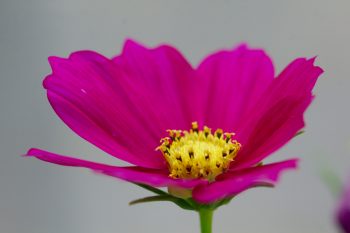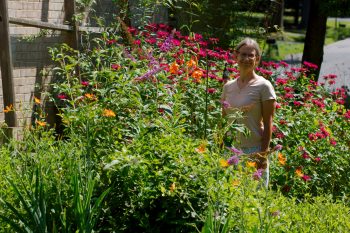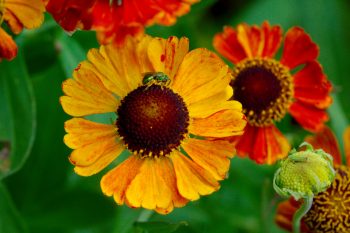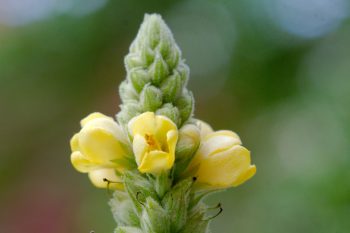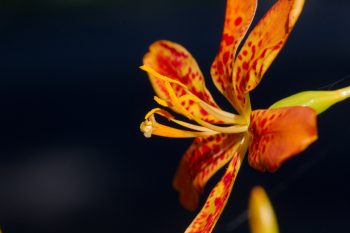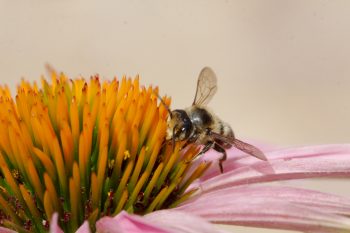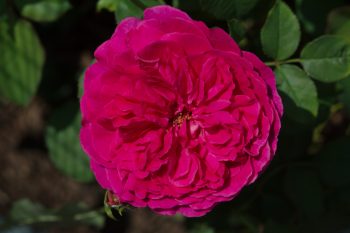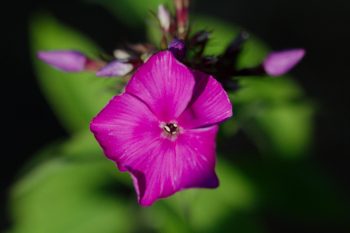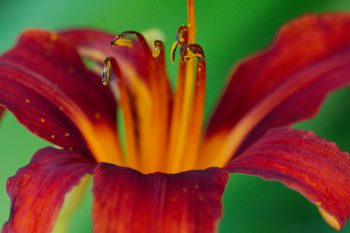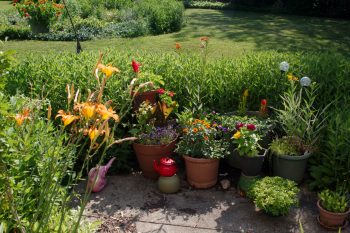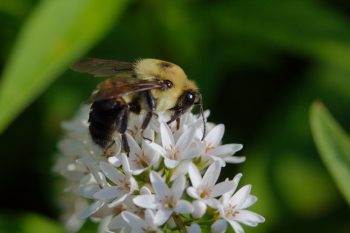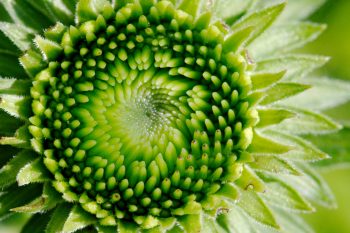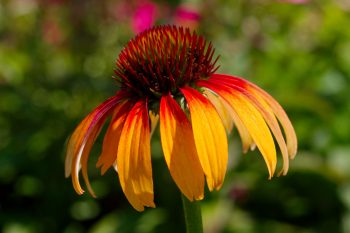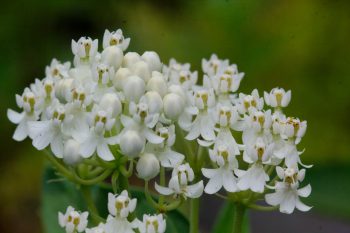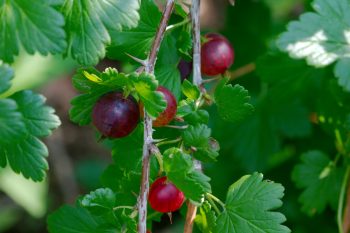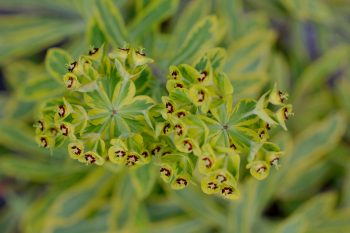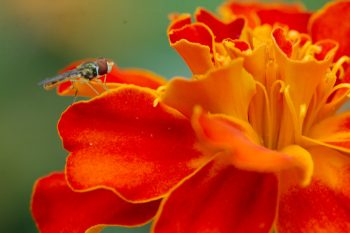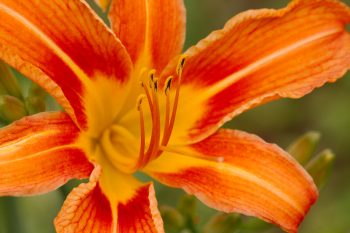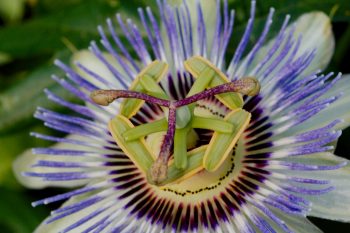I’ve seen some really impressive plantings of cosmos (Cosmos bipinnatus) but we’ve never had enough to really make a huge impression. Some years I think about getting a few packets of seeds but never seem to get around to it at the right time. This is from the ‘Sonata’ series and it a lovely color. They will self seed, if you’re lucky, and you’ll get repeat bloom from year to year, but we’ve only had an occasional plant from seed. Maybe next spring I’ll actually get my act together and put some seeds down. This and Nigella damascena (love-in-a-mist) are two that I think I could stand a lot more of.
Flowers and Plants
Cosmos bipinnatus ‘Sonata’
Cathy and Some Flowers
It was a work day today but as usual, a few times during the day we took a break from work and went outside briefly. It’s been hot, with about three weeks with high temperatures above 90° That’s not really our favorite thing, but the flowers blooming in the yard get us out, at least a little. Here’s Cathy at the south end of the house with some bee balm (Monarda didyma, the magenta flowers behind her), orange tiger lilies (Lilium lancifolium, off her right shoulder), Blackberry Lilies (Iris domestica, the slightly paler orange lower down and further to her right), and some purple butterfly bush (Buddleia). There are two roses on the frame against the wall but they are mostly without blooms right now.
Sneezeweed (Helenium ‘Mardi Gras’)
Cathy bought a few perennials over the weekend and I planted this one yesterday. It’s a sneezeweed called ‘Mardi Gras’ and it’s really nice. The flowers have a similar look to black-eyed Susans but it’s a different genus (Helenium). I happened to catch it with a little, green-sweat bee on it, which is a bonus. It prefers somewhat barren ground and isn’t supposed to do well in heavy clay, which is probably why I haven’t seen it around here. That’s really all we have. But hopefully it will survive, even if it doesn’t thrive too well.
Verbascum thapsus (Common Mullein)
This is the tip of a mullein stalk growing up close to the front of our house. It’s not really in a place I’d choose to plant it, but I left it there for Cathy. She really likes it and we have a fair amount in the hawthorn bed that has become something of a Mediterranean garden this year. It’s funny to hear so many people praise this plant as something the native Americans used medicinally. It may be true, but that only happened after it was introduced from Europe, as it isn’t a native American itself. It’s quite hardy (USDA Zones 3 to 9) and is quite happy in dry, otherwise barren places. This part of our yard really dries out in the summer and is currently rock hard. But along with the Verbascum we have Verbena bonariensis (tall verbena), Lavandula stoechas (Spanish lavender), and Salvia rosmarinus (rosemary), which all do well in rather severe conditions and in fact don’t like being waterlogged.
Iris domestica (Blackberry Lily)
The blackberry lily (Iris domestica, formerly known as Belamcanda chinensis, has beautiful, bright orange flowers above an attractive fan of sword-shaped leaves. It spreads slowly into clumps but mostly spreads by seed, which are distributed both by birds and by wives who really like it in our garden. I first collected seeds in South Carolina many, many years ago and we’ve had it around ever since. We have quite a few at this point and we may be reaching the time when a few of them need to be pulled up (but I’m not sure Cathy’s ready for that yet). They are native from the Himalayas to the Russian far east but do very well here. I like the lighting in this. The bloom is in full sun and the background is the pavement of our street in shadow.
Resin Bee on Coneflower
I wasn’t happy with most of the pictures I took today, but this one isn’t too bad. I’m pretty sure this is a sculptured resin bee (Megachile sculpturalis), although there are a few other Megachile species it could be (e.g. the flat-tailed leaf-cutter bee, Megachile mendica, which is more common). Regardless, it’s a nice, quiet little bee and it was moving among the coneflowers, along with a few other solitary bees and an occasional honey bee (Apis mellifera). I know that some folks are not fond of bees and don’t like to have them around. With the exception of a few aggressive hornets and wasps, I like having them around. They really rarely sting unless provoked and they are quite pretty to watch on flowers.
Rose ‘Munstead Wood’
The second of my three new David Austin roses has started to bloom. It’s called ‘Munstead Wood’ and as you can see, it’s a very double, old fashioned bloom. What you cannot get from the photo is the fragrance, which is very strong. I had to put some hardware cloth around this and one other because the rabbits were biting off the buds and eating them. Now that it’s protected, it’s going to town, with quite a few buds getting ready to open. Of course it’s still a relatively small plant, less than two feet tall, but I’m expecting it to be large enough that it provides a nice point of color in the middle of the garden.
Stock Photo
Over the years I’ve thought about selling photos as stock but I never really got into it. I’m not really sure if I’d actually make any money at it. I sort of doubt it, honestly. I know that now and then I get a reasonably good photo and I certainly enjoy both taking and looking at them. But whether they are actually suitable for stock is another matter. And of course it isn’t just that. They would have to be found among the hundreds of thousands of other stock photos. I’m sure there are ways to increase your chances but I’m not sure I care enough. So, I’ll just stick to what I do and occasionally post a photo with an attempt at a clever title. This is stock, Matthiola incana.
Fiery Day Lily
I love this day lily. It’s growing by our front walk in the shad of a pink dogwood. It seem really happy there and the colors are more intense in the afternoon, when they house casts its shadow over them. I love these colors, they’re so hot. It’s nice that they are along our walk, so I see them every time I go out the front door. Most of our day lilies are the more standard orange, which is nice, of course. We could do with more like this. Maybe I’ll divide these and spread them around a bit. Maybe I’ll even dig up some of the more aggressive perennials and replace them with these.
Back Patio
These are the containers in the south corner of our back patio, outside our kitchen door. They’re doing pretty well right now and really brighten up the back yard. There’s a lot of green in the yard, which isn’t all that unusual. Having some intense colors is really nice and annuals are so easy. There are some day lilies in the foreground on the left, which are in a container that fell over a few years ago and has been lying on its site for a few years. They don’t seem to mind in the least. There is also a hanging basket with Lantana in the upper left corner. Technically it is a broadleaf evergreen shrub but it isn’t hardy here and is generally grown as an annual.
Common Eastern Bumble Bee (Bombus impatiens)
Pretty much all the flowers in our garden are attractive to insects. I suppose that makes sense, because that’s what flowers are supposed to do, in order to get the insects to (inadvertently) pollinate the flowers. It’s interesting to me, though, that some flowers are attractive to many different insects but some seem to attract a specific subset. Yesterday, I was looking at the Monarda (bee balm) and noticed that the large bees were almost exclusively carpenter bees (Xylocopa virginica). Today I was looking at the gooseneck loosestrife (Lysimachia clethroides) shown here and the large bees were exclusively common eastern bumble bees (Bombus impatiens). Just interesting, that’s all.
On a mostly unrelated note, I really, really don’t recommend you plant any Lysimachia species in your garden. The bees love it, but there are other things they like that aren’t so overwhelming.
Coneflower
I love patterns in nature. Some are seemingly random but others, like the swirls in this coneflower, are strikingly organized. Even the random patterns have a rhythm to them, like the meandering of a river or the branching of an oak. Patterns are all around us and it’s worth looking for them and being reminded that it isn’t all a matter of chance. I’m a firm believer is a creator who designed all that is. I don’t understand some (or even most) aspects of the design but I appreciate them, nonetheless. This is a relatively simple pattern but very satisfying, at least to me.
‘Fiery Meadow Mama’ Coneflower
I could see a fairly large garden with nothing but varieties of coneflower (Echinacea species and varieties). One problem we have with them is that the rabbits and deer seem to like them and many that come up have their flowering stem bitten off so we don’t get flowers on them. The few that do bloom are great, of course, but then th bugs get to them and the petals get holes in them. They’re still nice, but not as photogenic. Because of that, we hesitate to buy more coneflowers. This one, called ‘Fiery Meadow Mama’, nearly made me make an exception. Wow, what a flower. There was another called ‘Cone-fections Hot Papaya’ that was mostly red and with a larger center that was nice, too. But we restrained ourselves.
Rose ‘The Poet’s Wife’
In April I ordered three David Austin Roses. They arrived on May 3 and because they were bare root, I put them in a pot until I could get around to planting them in the ground. I planted them two weeks later on May 17. This is the first of them to bloom. It’s called ‘The Poet’s Wife’ and it’s not clear for whom it is named. As you can see, it’s a yellow rose and along with the other two, I’m hoping it will do well in our garden. It’s supposed to grow to about four feet tall, although measurements like that are generally very specific but in practice fall within a very broad range. We’ll see.
Asclepias incarnata ‘Ice Ballet’
We’re big fans of Asclepias and have three species growing in our garden. We have a few varieties of Asclepias curassavica, a tender perennial native to the Caribbean and Central and South America often referred to as blood flower. We have several Asclepias tuberosa, butterfly weed, a hardy perennial native to our region. We just bought a few plants of a variety of Asclepias incarnata called ‘Ice Ballet’. The species is generally pale pink but this variety is a creamy white. It’s also a native to the area and is known as swamp milkweed. These will go in a spot that gets very wet when it rains, as these don’t mind that and there are a lot of things that won’t grow there.
Ripe Gooseberries
The gooseberries (Ribes uva-crispa) are just about ripe. The squerrals are eating them as they ripen up and I don’t think we’re actually going to get much of a harvest. That’s our own fault, because we haven’t protected them and aren’t going out each morning to pick them as they ripen up. I don’t mind, terribly, although I have been picking and eating them when I do go out. They are just the right combination of sweet and tart. If I had a bit of land and used some of it for vegetable gardening, I think I’d plant a row of these and put a net over them. I might put a net over this one next year, although it’s against the fence and that might make it tricky.
Euphorbia amygdaloides subsp. robbiae (Wood Spurge)
I took a few more pictures of plants on Cathy’s work table today. This one is a spurge called Euphorbia amygdaloides subsp. robbiae, also known as Robb’s wood spurge. It’s a nice combination of greens and yellows and something nice for the herbaceous border. The Euphorbia genus has something like 2,000 species and they range from small annual plants to trees and there are species from many parts of the world This one isn’t native to North America, but I’m not bothered by that. One thing you want to be careful of with these plants is their milky sap, which is poisonous if ingested and a skin irritant.
Syrphid Fly on Marigold
I went out to take some pictures of flowers today. There are a few sitting on a table that I set up for Cathy to work on and that seemed like a nice place to sit and take pictures. I took some of a coral bells plant (Heuchera x ‘Blondie’) and then I noticed this syrphid file (Family Syrphidae) on a marigold blossom. There’s only so close I can get with my 100mm macro and I’d like some way to get closer. I’ve thought about buying a Canon MP-E 65mm f/2.8 lens that gives magnifications of 1 to 5 times, basically picking up where my current lens leaves off. It’s manual focus, but at that close range, focus is as much a matter of moving the camera closer or further away from the subject.
Day Lily
The day lilies are starting to bloom. These are descendants from some we dug up in the woods of Pennsylvania, near our property. They are growing around what used to be a homestead, many years ago. There is a hole in the ground with the remains of stone walls and the base of a chimney. Around that are orange day lilies (Hemerocallis fulva) and periwinkle (Vinca minor) growing in great profusion. It’s in the shade as trees have grown up over it and in consequence the day lilies don’t bloom as well as they might, but we took a few home and planted them in the sun, where they bloomed quite happily. That was at our old house and we dug up and brought some of those with us here, where they continue to give a great show every year.
Blue Passion Flower (Passiflora caerulea)
This may actually be a hybrid of the blue passion flower (Passiflora caerulea) with something else, as that plant is generally only marginally hardy here and this one is clearly doing well. But I’m not sure. It is growing a few blocks from our house and we saw the buds on in a while back so I wanted to come get some photos of the blooms. We pass it on our walks sometimes, depending on the route we take. It’s growing in a nice, sunny location on a mailbox and is covered with blooms.

